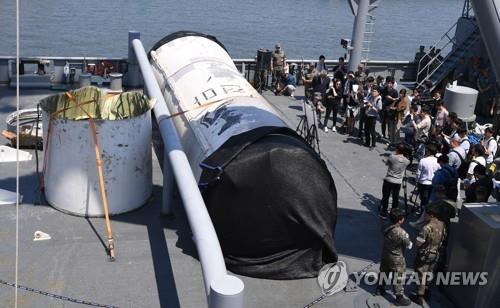- California Assembly OKs highest minimum wage in nation
- S. Korea unveils first graphic cigarette warnings
- US joins with South Korea, Japan in bid to deter North Korea
- LPGA golfer Chun In-gee finally back in action
- S. Korea won’t be top seed in final World Cup qualification round
- US men’s soccer misses 2nd straight Olympics
- US back on track in qualifying with 4-0 win over Guatemala
- High-intensity workout injuries spawn cottage industry
- CDC expands range of Zika mosquitoes into parts of Northeast
- Who knew? ‘The Walking Dead’ is helping families connect
S. Korea retrieves N. Korean spy satellite wreckage, ends salvage operation: military
South Korea has retrieved a North Korean spy satellite wreckage and concluded it has “no military utility,” Seoul’s military said Wednesday, ending a 36-day operation to salvage the sunken debris from a failed North Korean space rocket launch in late May.
The Joint Chiefs of Staff (JCS) said that the military raised key parts of the rocket and the satellite through the search and salvage operation in the Yellow Sea from May 31 through Wednesday, and it worked in tandem with the United States to examine and analyze them.
“As a result of the exhaustive analysis by South Korean and U.S. experts, we have assessed it has no military utility as a reconnaissance satellite,” the JCS said in a press release.
The military’s capability assessment on the satellite wreckage spawned speculation that it might have recovered key camera components or other pieces of optical equipment installed in the satellite. To perform as a full-fledged spy satellite, one has to have a sub-meter resolution camera, observers said.
The allies’ joint analysis drew keen attention as it could shed light on the progress of the North’s long-range rocket development and space programs, as well as which countries have wittingly or unwittingly aided its weapons development efforts.
The JCS did not detail the findings through the allies’ analysis of the wreckage nor did it disclose any photos of the retrieved part of the satellite.
Last month, a Seoul official struck a cautious note, insinuating that disclosing all the information the military gleaned from the salvage operation would rather benefit the North Korean military.
After the rocket fell into the waters some 200 kilometers west of the South Korean western island of Eocheong on May 31, the military carried out the retrieval operation involving Navy ships, maritime aircraft and deep-sea divers for over a month.
The operation had been hindered by poor underwater visibility, fast currents, the heavy weight of the sunken wreckage and other challenges.
But it raised a presumed part of the rocket’s second stage on June 15. The lifted part was around 12 meters long and 2 to 3 meters in diameter.
“Our military has demonstrated its outstanding operational capabilities as it recovered multiple parts of the wreckage despite the unforgiving operational environment,” the JCS said.
The North has claimed that the May 31 launch involved the new Chollima-1 rocket carrying the satellite, Malligyong-1. Soon after the botched launch, the North’s state media acknowledged the rocket crashed into the sea due to the abnormal starting of the second-stage engine.
Seoul and Washington have long viewed what the North claimed to be a space rocket launch as a violation of U.N. Security Council resolutions banning any launch using ballistic missile technology.












